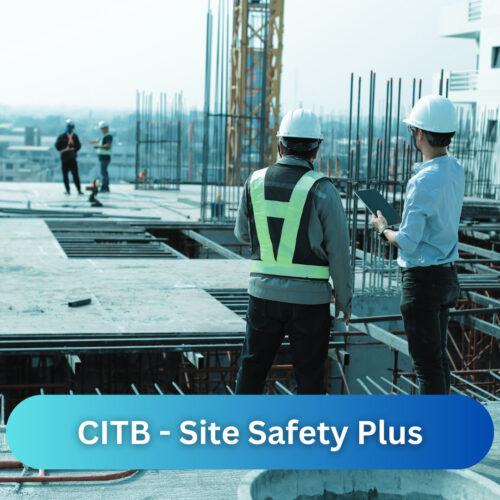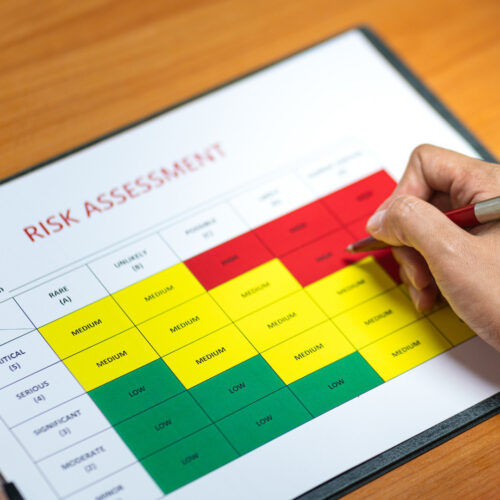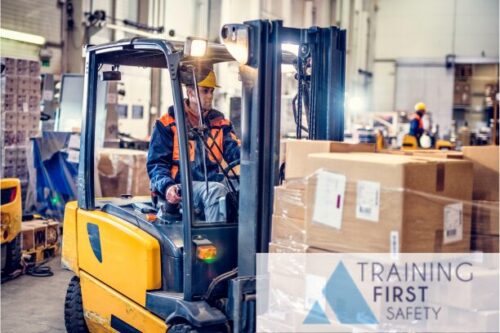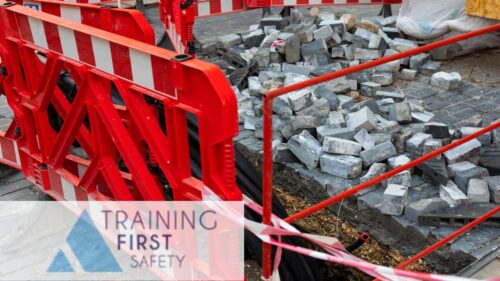- Have an increased awareness of the nature and properties of asbestos and its effects on health, including the increased risk of lung cancer for asbestos workers who smoke.
- Be familiar with the types, uses and likely occurrences of asbestos in buildings and where appropriate items of plant.
- Know how to avoid the risks from asbestos by understanding.
- Where to obtain information on asbestos in premises prior to commencing work.
- What to do if suspicious materials are found.
- How to use appropriate workplace precautions, including the risk assessment process, or seek advice on workplace precautions, in respect of the risks of asbestos.
- Undertake work activities in a safe manner and without risk to themselves or others.
- Have an awareness of the key aspects of the asbestos regulations and how they fit into the broader context of health and safety legislation.
- Procedures to be followed when coming into unintentional contact with asbestos containing materials (ACMs) and an understanding of the appropriate emergency arrangements.
-
 Asbestos Awareness Asbestos awareness training is required to be given to employees whose work could foreseeably expose them to asbestos. In particular, it should be given to all demolition workers and those workers in the refurbishment, maintenance and allied trades. Asbestos awareness training is not training to work with any forms of asbestos. It is likely to form the first part of training for work with asbestos, but on its own it is does not meet the legal requirements laid down under Control of Asbestos Regulations 2012 (CAR). The course objective is to provide an awareness and develop the knowledge amongst employees as regards the hazards and risks posed by asbestos containing materials (ACMs). The course further gives an overview of the legislative measures in place to permit employees to safeguard themselves and others affected by work activities. Learning Objective On successful completion of this course, delegates should be able to:
Asbestos Awareness Asbestos awareness training is required to be given to employees whose work could foreseeably expose them to asbestos. In particular, it should be given to all demolition workers and those workers in the refurbishment, maintenance and allied trades. Asbestos awareness training is not training to work with any forms of asbestos. It is likely to form the first part of training for work with asbestos, but on its own it is does not meet the legal requirements laid down under Control of Asbestos Regulations 2012 (CAR). The course objective is to provide an awareness and develop the knowledge amongst employees as regards the hazards and risks posed by asbestos containing materials (ACMs). The course further gives an overview of the legislative measures in place to permit employees to safeguard themselves and others affected by work activities. Learning Objective On successful completion of this course, delegates should be able to: -

IOSH Managing Safely
Who is Managing Safely for? Managing Safely is designed for manager and supervisors in any sector, and any organisation worldwide. They won’t suddenly become safety experts – but they’ll get up to speed on the practical actions they need to take and gain the knowledge and tools to tackle the safety and health issues they’re responsible for. Managing Safely makes a powerful case for safety and health being an integral part of day-to-day management and business. Managing Safely covers:- Assessing risks
- Controlling risks
- Understanding responsibilities
- Understanding hazards
- Investigating incidents
- Measuring performance
-

IOSH Managing Safely
Who is Managing Safely for? Managing Safely is designed for manager and supervisors in any sector, and any organisation worldwide. They won’t suddenly become safety experts – but they’ll get up to speed on the practical actions they need to take and gain the knowledge and tools to tackle the safety and health issues they’re responsible for. Managing Safely makes a powerful case for safety and health being an integral part of day-to-day management and business. Managing Safely covers:- Assessing risks
- Controlling risks
- Understanding responsibilities
- Understanding hazards
- Investigating incidents
- Measuring performance
-

Course Overview
The two-day Temporary Works Co-ordinator Training Course (TWCTC) is designed to assist those on site who have responsibility for managing all forms of Temporary Works. This course is not a general awareness course, its main focus is teaching roles and responsibilities a Temporary Works Co-ordinator would have. The TWCTC course will cover the following topics:- the need for and duties of a TWC
- the other key roles involved in temporary works
- the use of BS 5975:2019 in relation to the role
- typical documents used in temporary works
- other legislation and guidance that interact with temporary works
- the importance of the 4Cs: communication, co-ordination, co-operation and competence
- the need for risk management.
- Successful candidates will receive a Site Safety Plus accredited certificate upon completion, this certificate is valid for 5 years.
-
 This is a CITB Site Safety Plus course. It is designed for company directors, with the aim of recognising the human and financial implications of non-compliance with health & safety legislation. Who is the course for? The course is designed for company directors who wish to have a better understanding of their responsibilities with regard to health & safety legislation. Course content includes:
This is a CITB Site Safety Plus course. It is designed for company directors, with the aim of recognising the human and financial implications of non-compliance with health & safety legislation. Who is the course for? The course is designed for company directors who wish to have a better understanding of their responsibilities with regard to health & safety legislation. Course content includes:- Accountability of Directors
- HASWA 74
- Turnbull Report
- Criminal Offences Act
- Corporate Homicide & Manslaughter Act
- Achieving Best Practice
- Managing Health & Safety
- Outlines of specific regulations
- CDM Regulations
- Putting people to work safely
-
 This course covers all aspects of the use of harnesses in working at height applications. It enables delegates to select and use harnesses correctly. If a delegate has an IPAF licence this qualification can be added to their digital licence.
This course covers all aspects of the use of harnesses in working at height applications. It enables delegates to select and use harnesses correctly. If a delegate has an IPAF licence this qualification can be added to their digital licence.Who Is This Course For?
Anyone who uses a harness in any type of working at height application. Please note this course does not cover inspection of Harnesses. We do offer a separate 1/2 day Inspection course.Course Structure
- Employer’s and employee’s legal responsibilities
- MEWPs and harnesses
- Hierarchy of personal fall protection equipment
- Choice of harness and lanyard
- Anchor points
- Pre use checks and correct usage
- Rescue situations
- Cleaning and storage
- Written Theory Test
Course Completion
Delegates will take a short written test. Successful delegates will receive a training certificate. -
 This course covers all aspects of the awareness (HA) use (HU) and inspection (HI) of harnesses in working at height applications, it will enable delegates to use and inspect harnesses correctly. If a delegate has an IPAF licence, this qualification can be added to this.
This course covers all aspects of the awareness (HA) use (HU) and inspection (HI) of harnesses in working at height applications, it will enable delegates to use and inspect harnesses correctly. If a delegate has an IPAF licence, this qualification can be added to this.Who Is This Course For?
Anyone who needs to be able to use and inspect harnesses in any type of working at height application and be able to sign them off for use.Course Structure
- Employer’s and employee’s legal responsibilities
- MEWPs and harnesses
- Hierarchy of personal fall protection equipment
- Choice of harness and lanyard
- Anchor points
- Pre use checks and correct usage
- Rescue situations
- Cleaning and storage
- Statutory Inspections
- Types of detailed inspection
- Common types of damage & criteria for failure
- Inspection reports
- Written Theory Test
Course Completion
Successful delegates will receive a digital IPAF certificate as well as access to the IPAF ePal App. -
 The PASMA Towers for Users training course is the best known and most recognised qualification for the safe assembly and dismantling of aluminium scaffold towers. The morning session is in the classroom, followed by a short written test. The afternoon session is practical training, involving the building and dismantling of scaffold towers.
The PASMA Towers for Users training course is the best known and most recognised qualification for the safe assembly and dismantling of aluminium scaffold towers. The morning session is in the classroom, followed by a short written test. The afternoon session is practical training, involving the building and dismantling of scaffold towers.Who Is This Course For?
Anyone who works with the assembly and dismantling of aluminium mobile access towers on site or in a commercial environment.Course Structure
- Employer’s and employee’s legal responsibilities
- Tower components
- Pre-use inspection
- Safe methods of erection & dismantling
- Variances in manufacture
- Common hazards
- Practical training
-
 Course Overview This course will train delegates to carry out Portable Appliance (PAT) Testing using appropriate testing equipment. We have our own testing equipment which we train delegates to use, but delegates are also welcome to bring their own equipment with them for training if they wish. Please note that the course does not cover 3 phase equipment. Who is the course for? Anyone wishing to become an appointed person for Portable Appliance (PAT) testing within organizations using portable appliances. Course content includes:
Course Overview This course will train delegates to carry out Portable Appliance (PAT) Testing using appropriate testing equipment. We have our own testing equipment which we train delegates to use, but delegates are also welcome to bring their own equipment with them for training if they wish. Please note that the course does not cover 3 phase equipment. Who is the course for? Anyone wishing to become an appointed person for Portable Appliance (PAT) testing within organizations using portable appliances. Course content includes:- Employer’s and employee’s legal responsibilities
- Visual inspections
- Class I Tests
- Class II Tests
- Flash testing
- Hazards of incorrect testing
- Electronic tester operating techniques
- Recording results
- Labelling of equipment
-
 Course Overview This course trains employees in writing Risk Assessments and Method Statements, enabling them to produce these documents for their employer. Who is the course for? Anyone who needs to produce Risk Assessments and Method Statements as part of their work. Examples are managers, supervisors, health & safety representatives. Course content includes:
Course Overview This course trains employees in writing Risk Assessments and Method Statements, enabling them to produce these documents for their employer. Who is the course for? Anyone who needs to produce Risk Assessments and Method Statements as part of their work. Examples are managers, supervisors, health & safety representatives. Course content includes:- Definitions of hazard and risk
- Regulatory overview and legal duties
- Definitions
- Principles of prevention
- 5 Steps to Risk Assessment
- Quantitative and qualitative assessment
- Recording of significant findings
- Method statement development
- Effective communication
- Control systems & monitoring
-
 A 3 day course on counterbalance forklifts. This course is for experienced operators who have not received any previous training. Who is the course for? This course provides accredited training for operators who are experienced in driving trucks, but who have not had any previous training. Course content includes:
A 3 day course on counterbalance forklifts. This course is for experienced operators who have not received any previous training. Who is the course for? This course provides accredited training for operators who are experienced in driving trucks, but who have not had any previous training. Course content includes:- Employer's and employee's legal responsibilities
- Hazards arising from the use of fork lift trucks
- Basic maintenance
- Longitudinal and lateral stability
- Pre-use inspection
- Setup to lift various loads
- Differing terrains
- Manoeuvring in confined areas
- Keeping within safe working parameters

